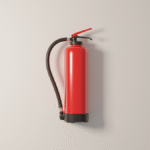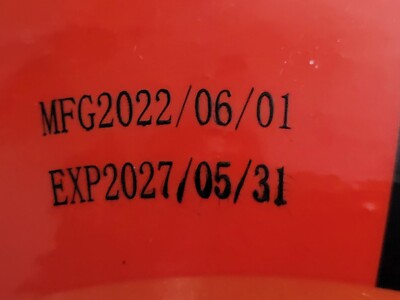When was the last time you checked your fire extinguisher? For most people, the answer is “never” or “a long time ago.” Yet, in emergencies, a properly functioning fire extinguisher can mean the difference between a minor incident and a devastating disaster. Knowing how to check a fire extinguisher’s expiry date is one of the simplest yet most crucial steps in fire safety management.
Fire extinguishers, like all safety equipment, don’t last forever. Over time, their effectiveness declines, and an expired or faulty extinguisher can fail when you need it most. Whether you’re a homeowner, business owner, or simply someone concerned about workplace safety, understanding how to verify your extinguisher’s condition is essential. This article explains how to check expiry dates, recognize warning signs, and maintain extinguishers for maximum safety.
Why Fire Extinguisher Expiry Dates Matter
Fire extinguishers are first line defense tools against small fires. According to the National Fire Protection Association (NFPA), fire extinguishers successfully put out more than 95% of home and office fires when used correctly. However, these statistics only hold true if the extinguisher is in proper working condition.
An expired fire extinguisher may:
- Fail to discharge properly.
- Have low or no pressure.
- Contain degraded chemicals that are ineffective.
- Be corroded or damaged, making it unsafe to use.
In real life scenarios, many fire related tragedies could have been prevented if extinguishers were checked and replaced on time. This is why routine inspection and expiry date verification are critical parts of fire safety management.
How to Check Fire Extinguisher Expiry Date
1. Look for the Manufacturing Date
Most fire extinguishers do not have a direct “expiry date” printed. Instead, they carry a manufacturing date, usually stamped on the cylinder body or printed on the label. It may appear as:
- Month/Year (e.g., 07/2021)
- Year only (e.g., 2020)
- A code or serial number (refer to manufacturer’s guide).
From the manufacturing date, you can calculate the lifespan of the extinguisher. Typically, disposable fire extinguishers last 5 to 15 years, depending on type and brand.
2. Check the Expiry Period Based on Extinguisher Type
Different types of fire extinguishers have different lifespans:
- Dry Chemical Powder Extinguishers: 10 to 12 years (with proper maintenance).
- Carbon Dioxide (CO2) Extinguishers: 10 years.
- Foam Extinguishers: Around 5 years before refilling is required.
- Water Extinguishers: 5 to 10 years, depending on usage and servicing.
Always cross check with manufacturer recommendations and local fire safety regulations.
3. Inspect the Pressure Gauge
A quick way to determine if your extinguisher is still operational is by checking the pressure gauge (if available).
- Green Zone: Safe and ready for use.
- Red Zone (Low): Insufficient pressure may not work.
- Red Zone (High): Over pressurized, potentially dangerous.
If the needle isn’t in the green zone, the extinguisher should be serviced or replaced.
4. Look for Service Tags and Maintenance Records
Most workplaces and commercial spaces are required to service fire extinguishers annually. After inspection, technicians attach a service tag that records the last check up date and next due date. If the service tag is missing or outdated, your extinguisher may already be expired.
5. Watch for Physical Signs of Expiry
Beyond dates and gauges, some physical signs indicate that an extinguisher is no longer reliable:
- Rust, corrosion, or dents on the cylinder.
- Broken or missing safety pin.
- Leakage or clogged nozzle.
- Faded or unreadable labels.
If any of these signs appear, the extinguisher should be replaced immediately.
Tips for Maintaining Fire Extinguishers
Regular Inspections
- Monthly Check: Ensure the extinguisher is in place, accessible, and pressure is in the green zone.
- Annual Service: Hire certified professionals for a detailed inspection.
- Hydrostatic Testing: Required every 5 to 12 years, depending on type, to check cylinder integrity.
Record Keeping
Keep a log of purchase dates, servicing schedules, and replacements. This ensures you never miss an expiry date.
Proper Storage
Store fire extinguishers in easily accessible, visible locations. Avoid damp or corrosive environments that can shorten lifespan.
Employee / Household Training
A working extinguisher is only useful if people know how to use it. Conduct basic training on the PASS method (Pull, Aim, Squeeze, Sweep).
Advantages of Checking Expiry Dates Regularly
- Enhanced Safety: Ensures extinguishers work effectively during emergencies.
- Legal Compliance: Meets workplace safety laws and insurance requirements.
- Cost Savings: Early maintenance prevents costly damage from uncontrolled fires.
- Peace of Mind: Knowing your extinguisher is ready reduces stress in emergencies.
Common Misconceptions About Fire Extinguisher Expiry Dates
- Extinguishers last forever. False. They degrade over time.
- If it looks fine, it must be fine. Not true; internal issues may not be visible.
- I’ll replace it only after use. Dangerous, as unused extinguishers also expire.
Understanding these myths ensures you don’t unknowingly keep expired safety equipment.
Conclusion
Fire extinguishers are silent guardians in our homes, offices, and vehicles ready to protect us in emergencies. But like all safety tools, they have a limited life span. By learning how to check a fire extinguisher’s expiry date from reading the manufacturing date to inspecting gauges and service tags you ensure your extinguisher will be reliable when it matters most.
Key Takeaway: Never assume your extinguisher is in good condition. Regularly check expiry dates, maintain service schedules, and replace outdated units. Safety is not just about having equipment it’s about keeping it effective.
Call to Action: Take five minutes today to inspect your fire extinguisher. That small step could save lives tomorrow.




